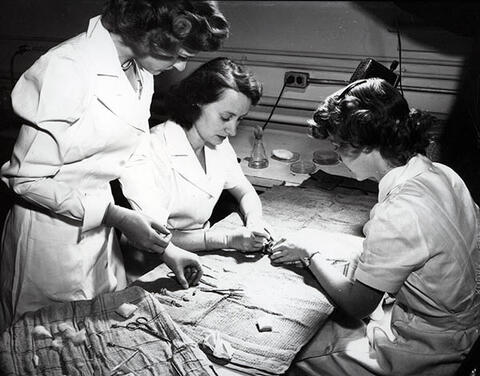
Title and statement of responsibility area
Titel
Dr. Althea N. Burton, I. Wynn and [Helen] Rublee - Encephalomyelitis Research
Algemene aanduiding van het materiaal
- Graphic material
Parallelle titel
Overige titelinformatie
Title statements of responsibility
Titel aantekeningen
Beschrijvingsniveau
Stuk
archiefbewaarplaats
referentie code
Editie
Editie
Edition statement of responsibility
Class of material specific details area
Statement of scale (cartographic)
Statement of projection (cartographic)
Statement of coordinates (cartographic)
Statement of scale (architectural)
Issuing jurisdiction and denomination (philatelic)
Datering archiefvorming
Datum(s)
-
Apr. 1948 (Vervaardig)
Fysieke beschrijving
Fysieke beschrijving
1 photograph : b&w ; 9 x 12 cm
Publisher's series area
Title proper of publisher's series
Parallel titles of publisher's series
Other title information of publisher's series
Statement of responsibility relating to publisher's series
Numbering within publisher's series
Note on publisher's series
Archivistische beschrijving
Naam van de archiefvormer
Geschiedenis beheer
Bereik en inhoud
Dr. Althea N. Burton (centre), veterinary surgeon, working with I. Wynn (at Dr. Burton’s left) and [Helen]. Rublee (right), laboratory technicians, to transfer a virus to a live guinea pig.
Bio/Historical Note from news clipping: “Part of the technique of producing vaccine for encephalomyelitis or “sleeping sickness” in horses is shown here. Dr. Althea N. Burton (second from left), veterinary surgeon at the university’s animal diseases laboratory, is transferring a deadly virus obtained from the brain of a dead guinea pig to that of a live one. The animal’s skull has been anaesthetized and it feels no pain, and will die within four days. Laboratory technicians like I. Wynn (at Dr. Burton’s left) and H. Rublee (right), will remove the brain and place it in a glycerine preservative, keeping it there for a maximum of two weeks. The brain is then ground up and placed in a solution which is injected into an 11-day chicken embryo. Mamie C. Janzen (see A- 3643), is shown in this operation at far right. The egg shell is sealed with wax and incubated a further 24 hours, the length of time for the virus to kill the embryo. Removed from the shell and ground up in a “colloid mill”, formalin is added to the embryo to kill the virus. The vaccine is then filtered, diluted in saline solution, and stored for two weeks to ensure the death of the entire virus. In this form it is bottled and shipped to prairie druggist[s] from whom farmers buy it and inoculate their horses at a total cost of $1 per horse.” From Saskatoon Star-Phoenix, Apr. 1948.
Bio/Historical Note: In the mid-1940s Dr. J.S. Fulton and his research colleague, Dr. Althea N. Burton, modified the Western Equine Encephalitis Vaccine (WEE) so it could be used in humans. Burton initially worked as a technician in Fulton’s lab before completing her veterinary degree at the Ontario Veterinary College in 1947. After Fulton’s retirement in 1958, Burton continued the WEE studies in collaboration with other Saskatoon scientists — including professional and amateur entomologists. This collaborative team eventually confirmed that the WEE virus overwintered on the Prairies and was transmitted to birds, horses and humans through mosquito species. In 1966 the United States government granted $95,000 to a research team at the U of S for studies of western encephalitis. The grant, spread over three years, was made for research by Dr. Jacob G. Rempel, professor of Biology, and by Dr. Burton. Although research into the disease had been underway in Saskatchewan since the 1930s, the work was intensified with the announcement of the South Saskatchewan River Project and the Saskatoon team has produced results sufficiently impressive to attract international attention. More than 40 years later, findings from those foundational studies in WEE became invaluable as public health teams in Western Canada learned to deal with the spread of West Nile virus — another mosquito-borne arbovirus that affects birds, horses and humans.
Aantekeningen
Materiële staat
Directe bron van verwerving
Ordening
Taal van het materiaal
Schrift van het materiaal
Plaats van originelen
Beschikbaarheid in andere opslagformaten
Restrictions on access
Termen voor gebruik, reproductie en publicatie.
Photographer: Saskatoon Star-Phoenix
Copyright: University of Saskatchewan
Toegangen
Associated materials
Aanvullingen
Algemene aantekening
See A-3643 for second image of series.

